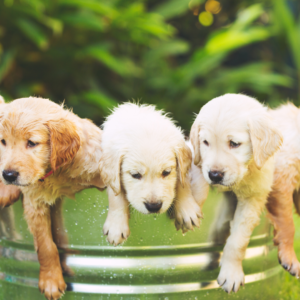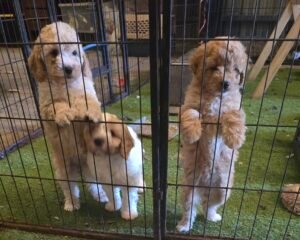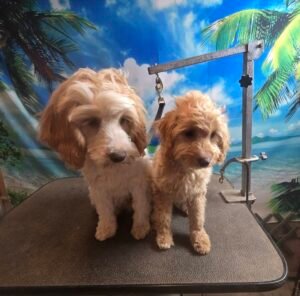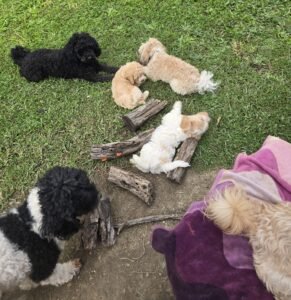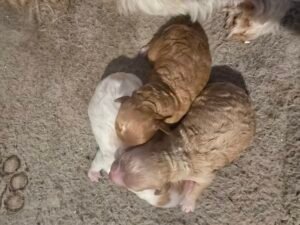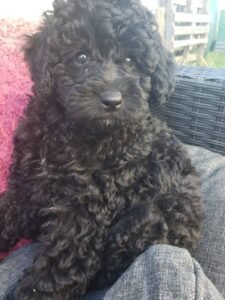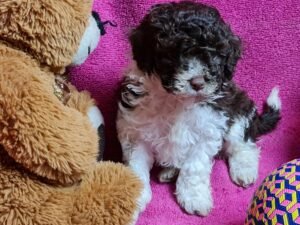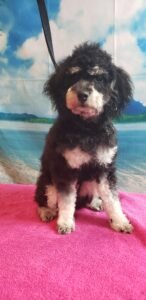Big dogs, small dogs, cute white fluffy dogs, long legs, short legs, tail or no tail, protective, guarding or friendly lapdogs (who help the thief carry out the silver and nose out the spare cash). Just as dogs come in a multitude of shapes, sizes and temperaments they also come in a multitude of coat types. Long and short, single, double or triple, hair shedding 24/7, seasonally or never are examples. The size and temperament of a dog is important but equally so is its coat type.
Wild dogs do not have long flowing impractical coats. Dogs from colder Northern Hemisphere climates have double or triple coats that shed continuously, protecting them from extreme cold. Poodles, Shih Tzu, Cavaliers, Maltese and Pomeranians, are long coated breeds developed many centuries ago by Royalty or Emperors who had unlimited time, money and staff to care for their beautiful elegant coats.
Working breeds such as Jack Russell, Cattle Dogs, German Shepherds, Rottweilers, Dobermans, Golden Retriever or Labradors have short dense coats as they were developed to work in water or underground. They tend to shed hair constantly and often in greater amounts that long coated breeds.
Dogs are man’s best friend and responsible owners keep their dogs shiny, attractive and healthy. A dog coat that is matted, full of dead hair and smelly results in an unhappy, unhealthy and often flea loaded dog. Mats form when dirt collects in the coat making small knots, the dog scratches at this knot making it larger and larger as more dirt accumulates. Air is unable to circulate around the skin, fleas and ticks are in heaven and sores and rashes form.
Heavily matted dogs are unable to move their legs or feet correctly due to constriction and pain from matts under legs, elbows and in some cases the full back. Many dogs become aggressive as they can only exhibit pain by biting. To find out how your dog feels with a matted coat, grab two big handfuls of your own hair and pull tightly. How long can you tolerate this for? Removal of these matts is a painful and dangerous process, despite a groomer’s experience, pulling on the skin is required and the risk of accidentally cutting the dog is high, especially if they have become overly aggressive. In extreme cases full anesthesia is required in a veterinary surgery.
The rate at which coats matt will depends on the type of coat. Poodles, Shih Tzu and Maltese rapidly progress from a knot that is easily removed to a total nightmare that only a good set of clippers and a qualified dog groomer can fix. The designer dog breeds are a particularly difficult problem due to the inappropriate combination of different coat types resulting in faster and harder matting. Many oodles that are not professionally groomed every 6 weeks develop full body matting.
In the 21st century dogs are an integral part of modern life, and can be owned by rich and poor alike. But our modern lifestyle means we have far less time to care for the coat needs of these dogs and often not the money to pay others to perform the required grooming.
Dog grooming can be simplified into three main categories
(1) Clip: (e.g. Poodles, Shih Tzu, Maltese and Cocker Spaniels). Due to their single coats they clip without damage to the correct coat type. They are clipped to reduce coat maintenance and not to keep them cooler. Silky and Aussie Terriers can fall into this group; however, they only need light face and bottom trimming for hygiene reasons.
(2) Brush daily/strip fortnightly (e.g. Labradors, Australian Cattle Dogs, Kelpies, Corgis, Siberian Huskies, German Shepherds, Samoyeds, Malamutes, Pomeranians, Golden Retrievers, Jack Russell, and Fox Terriers). Stripping involves the use of a stripping brush, available at all good pet shops, for about 10 minutes per fortnight to remove loose wooly undercoat that sheds constantly. This will result in a coarser coat with shedding reduced by up to 75%
(3) Brush weekly and strip seasonally: (e.g. Border Collies, Belgian Shepherds, and Cavalier King Charles Spaniel). Despite being long coated these breeds are seasonal shedders who benefit from weekly brushing with a slicker brush to keep the shine but coat removal only when “blowing” coat at the end of summer and winter.
Dogs in group 2 and 3 above should never be clipped. Heat management in dogs is performed by exchange of heat via the tongue and the pads of the feet. In hot weather dogs pant and open their mouths wide to cool off. They often stand in water. They do not sweat from pores on their skin like humans and totally removing the coat to the skin will make the dog hotter as the insulating properties of a normal coat are removed. They can badly sunburn when skin not suited to sun exposure is bared. Continued clipping over time replaces the normal coat with the thick wooly undercoat that sheds, causes heat stress, and provides the ideal environment for fleas and ticks.
How can you tell if your dog is fully brushed out? If you are unable to run a comb through the full thickness of the coat down to the skin then your dog is not fully brushed. The choice of the right brush for your dogs coat is essential. Different coats require different bushes and different techniques. Most good pet shops in your area are only too happy to provide information on the right brushes for your dog. Grooming salons are also a source of information on the care of your favorite friend.
Happy clipping


Kareema
Healing Energy Animals
Kareema is the owners of Healing Energy Animals where devil dogs, horrible horses and crazy cats are turned into perfect pets using Relationship Animal Training and over 50 years of experience training a wide variety of animals.
Healing Energy Animals provides owners and pet professionals assistance with with common pet behavior training, feeding and grooming issues such as barking, escaping, scratching, aggression and fleas. Kareema consults and writes widely on a range of pet care issues for owners and also assists pet care professionals in setting up and growing their businesses by the provision of customer handling advice, sales and marketing strategies and up to date product information that allows for the differentiation of their pet care business from their competitors.
Healing Energy Animals is an Australian business but operates worldwide via the provision of virtual services.

